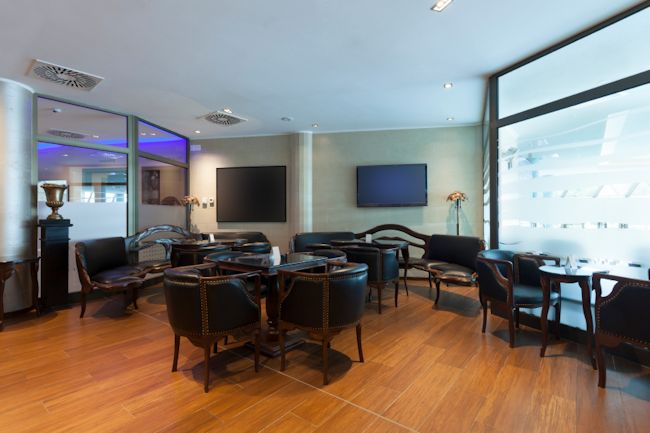
By Larry Mogelonsky, MBA, P. Eng. (www.lma.ca)
You’ve probably heard the term ‘third space’ thrown around here and there, and you’ve probably given it some thought. With all the recent shifts in consumer behavior, however, it’s important that you understand this concept in full and how you might use it to enhance a property’s atmosphere. To summarize, the third space describes a place where people congregate outside of the home (first space) and the office (second space). If you can engineer parts of your hotel – the lobby, the restaurant, the bar, the café and so forth – as flourishing third spaces, then it will play to your advantage for both higher occupancy levels and hotel cachet. (It’s also called the ‘third place’, but I prefer ‘space’ over ‘place’ because the former has less of a ‘runner up’ connation.)
Originally coined by the sociologist Ray Oldenburg in his book “The Great Good Place”, the term is formally used to represent public or neutral centers for community building, civic engagement, intellectual discourse, peer encouragement and group validation. Cafés, markets, bazaars, pubs, bars, clubs, shopping malls, plazas, gyms, spas, barber shops, hair salons recreation halls and even post offices can fit the bill as long as they are designed correctly. Third spaces are, in essence, places where we can unleash our social animals by exchanging opinions, stories and theories to the benefit of all present.
As stock as they now are, the examples of Starbucks and Panera Bread cannot be ignored in this regard. Both franchises have experienced exponential growth in the past two decades principally due to their superb products but also because of the atmosphere their stores exude. At Starbucks, for instance, the vibe is not one of ‘grab and get out as quickly as possible’, even though that is a very likely consumer action. Rather, the universal application of warmly colored furnishings and humble décor at their shops encourages customers to sit and enjoy their beverage or snack. Follow their lead: designing an F&B outlet with the third space in mind will boost sales.
Fun fact: it’s been postulated that, in the past, such third spaces like taverns, inns and coffee houses have acted as the points of inception for many ground-breaking inventions and social revolutions. With the aid of caffeine, alcohol and (on occasional) other potent stimulants, such habitats have facilitated the free flow of grand ideas amongst the intelligentsia of the times and the rallying behind righteous causes. A noteworthy example here is the American War for Independence with many of the first revolutionaries all consistently gathering at the same watering holes in colonial Boston. If hotels strive to be not only places of rest but also progressive community leaders, then they must promote the ideals of the third space.
Why Care, Why Now
The reality today is that third spaces are almost as important as the home and the office because they are the places that individuals frequent to enrich their lifestyles. It’s what you do and where you go that largely defines who you are after all. Working in hospitality should mean more than just looking at numbers. We should aim to nurture our guests sand offer them a common area to develop their own identities. This isn’t a quality captured in most accounting ledgers, but it will certainly have an emotional impact on your travelers, reflected by increased loyalty and positive word of mouth.
Given that more and more people are working from home – thus combining the first and second places – the desire to offset any monotony of visual stimuli will only be exacerbated. Visiting a local hotspot, for instance, can service the need for the external, novel stimulation. The word ‘hotspot’ should not be underestimated in this regard as crowds of merry revelers will often provide more stimulation and enjoyment than a quiet, sparsely occupied setting. Simply put, people want to be where the action is.
In addition to this tech-dependent trend (as digital communications have accelerated the merger of first and second spaces), neutral third spaces such as cafés, bars and restaurants are now much more likely to double as conduits for casual business meetings and interviews. Of course, this shift in consumer behavior and use of space dovetails the rise in buying power of the Gen X and Millennial generations. With more surplus cash comes increased spending and more time allotted for public gatherings – both outcomes that make these two demographics key proponents of the third space, especially as they continue to mature.
Gen Xers and Millennials are also the ones most associated with internet fluency, electronic communications and social media usage. I mention this because, technically speaking, these digital interactions are a form of social discourse. We now live in a very social world, and, accept it or not, smartphones play a significant role in our collective culture. Hence, a solo person accessing the internet for this express purpose while in a neutral setting is, in today’s standards, a third space participant. He or she could be on their phone anywhere, but they choose to be in, and contribute to, a social ambiance. The takeaway: the more smartphones proliferate, the greater the need for third spaces.
One last general point to discuss is the cross-pollination effect between guestroom bookings and the in-house third space. As mentioned before, people want to be where the action is. If a hotel gains a reputation as a hotbed of activity, then locals will help by referring this property to incoming travelers seeking a social atmosphere.
Third Space Criteria
As the proprietor, it’s your job to configure parts of your hotels so that they are optimized for a third space. You don’t have to meet all of these standards, but the more you can check off, the better your chances of propagating a hotspot in your hotel. For instance, the reception area of your fitness facilities or spa likely won’t be able to meet any alcoholic beverage criterion, but that doesn’t mean you can’t compensate by augmenting other aspects.
1. Accessibility. If consumers can’t find your neutral space then it will be seldom frequented. In order to generate that critical mass, you have to make your restaurant, bar or lounge convenient for everyone. Think in the lobby and within sight of the front desk or elevators. Signage is always good, too. Moreover, part of accessibility means long hours stretching beyond one specific mealtime as well as minimal elitisms (cover charges, membership requirements, reservations, dress codes and so on). By eliminating the barriers or penalties, you promote belonging and equality in conversation.
2. Ambiance. Just as you don’t want to be pretentious in the accessibility department, you likewise will want to strive for an informal, unassuming manner in your overall décor. This means that the lighting is not excessively dimmed, thus allowing people to gather for work purposes. It also means that the music isn’t too loud or clubby; aim for a playlist that inspires a lighthearted spirit with perhaps samplings of cool jazz, blues, Motown favorites and indie rock. Additionally, consult an interior designer to learn about some of the more clever ways you can induce a steady flow of conversation, like how ample amounts of the color green are scientifically known to enhance creative thought.
3. Stylish yet Ergonomic Seating. You don’t have to emulate a lavish supper club in this regard, but on the other hand, you don’t want to aim for a clinical, white-walled classroom look either. Give patrons comfortable, upright chairs positioned around tables large enough to spread out a few papers or laptops. Do so abundantly to allow for a large congregation and a reasonable amount of people watching. Next, throw some couches and divans in for variety, but don’t go overboard as these eat up a lot of space.
4. Quality F&B. Good people and good dialogue go hand-in-hand with quality food, coffee, craft beers and mixology. Just as pints of ale were the third space lubricants in the taverns of yesteryear, so too must you weigh in on the significance of libations for your third space. Alcohol isn’t mandatory (and neither is food), but it certainly helps set the tone, as does high-end coffee. Fascinating cuisine and cocktail choices can also make for great conversation starters.
5. Tech Support. It’s the 21st century; people want to hang out with their devices. Power outlets should be the opposite of sparse and hidden, even if that means running a few extra wires around the place. Then if you really want to propagate a bustling haven, make WiFi free.
6. Grab and Go. You shouldn’t expect every patron ambling by to want to sit down for an extended period of time, even though this is something your space should encourage. Instead, consider some facets of self-serve molded in for flexibility – pastry carts, buffet stations and so on. True, including these features may make your third space feel less ‘classy’, but it will also create the semblance of efficiency thereby increasing your accessibility quotient.
7. Savvy Staff. The last main characteristic of a modern third space is the presence of regular patrons. Sometimes you just want to go ‘where everybody knows your name’. And just like the hit TV show “Cheers”, your waitstaff are the connective glue to nurture steady guests and convert first-timers into long-standing habitués. I say ‘savvy’ because you can’t just hire anyone. They have to be socially smart, able to remember who the regulars are (even after weeks or months of absence), thoroughly knowledgeable on all menu items and receptive to inducting newcomers by opening the conversation. Without great staff, no other point listed above will matter.
________
This article may not be reproduced without the expressed permission of the author.


